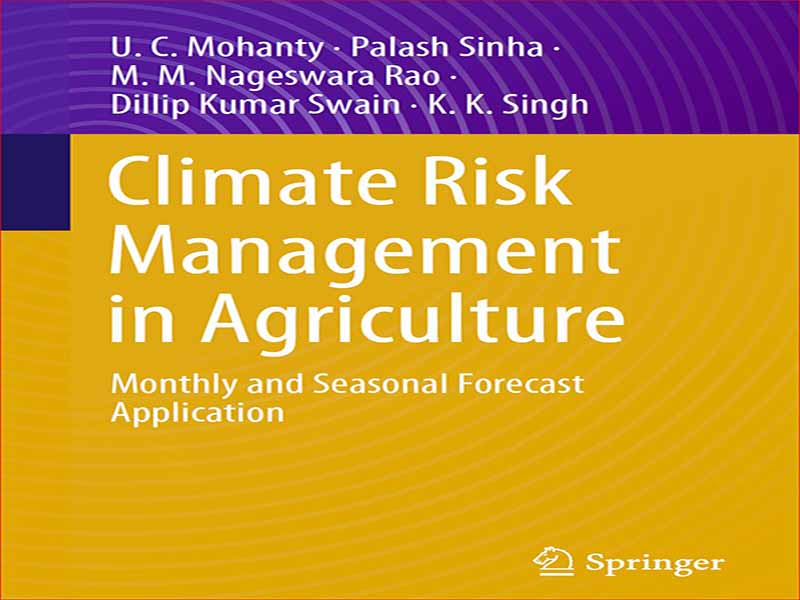- عنوان کتاب: Climate Risk Management in Agriculture
- نویسنده/انتشارات: U. C. Mohanty
- حوزه: تغییرات آب و هوا
- سال انتشار: 2024
- تعداد صفحه: 374
- زبان اصلی: انگلیسی
- نوع فایل: pdf
- حجم فایل: 21.3 مگابایت
در هند، بیش از 50٪ از جمعیت در کشاورزی و فعالیت های وابسته به آن مشغول هستند، که حدود 18٪ در ارزش افزوده ناخالص این کشور مشارکت دارند (گزارش سرشماری 2021). علاوه بر این، بیش از 50 درصد از کل تولیدات کشاورزی از ناحیه دیم حاصل می شود که 60 درصد از کل زمین کشاورزی را پوشش می دهد و در برابر خطرات آب و هوایی بسیار آسیب پذیر است. تغییرات آب و هوایی فصلی از نظر خشکسالی، سیل ناگهانی، بارندگی شدید، رعد و برق، طوفان، امواج گرما و غیره به شدت بر تولیدات کشاورزی، به ویژه کشاورزی دیم و اقتصاد روستایی تأثیر می گذارد. برای جلوگیری از چنین خطرات مربوط به آب و هوا، برنامه ریزی محصول مبتنی بر آب و هوا ضروری است، بنابراین، پیش بینی دقیق آب و هوا یکی از ورودی های مهم برای مدیریت تولید کشاورزی است.
اگرچه پیشرفتهای متعددی در درک علم جو و توسعه پیشبینی مدل فیزیکی و آماری برای آب و هوا و آب و هوا انجام شده است، با این حال، پیشبینی در مقیاس ماهانه تا فصلی دشوارترین و چالش برانگیزترین کار برای جامعه پژوهشی است. . این عمدتا به دلیل منطقه گرمسیری است، جایی که تعامل بین فرآیندهای فیزیکی در مقیاس کوچک با جریان در مقیاس بزرگ بسیار پیچیده است، و ویژگیهای سطح زمین بسیار ناهمگن هستند. به عنوان مثال، فصل باران های موسمی هند در سال 2002 (ژوئن-سپتامبر) یک سال خشکسالی (-19٪ از میانگین دوره طولانی) به دلیل خروج بارندگی زیاد در ماه ژوئیه (-49٪ از حد نرمال) بود. شدید در تاریخ ثبت شده باشد. از آنجایی که ماه ژوئیه حیاتی ترین ماه برای کاشت محصول خریف است، تولید غلات غذایی به 183 میلیون تن در مقایسه با 212 میلیون تن در سال قبل کاهش یافت که دلیل آن تغییر بی سابقه بارندگی درون فصلی در آن سال بود. علاوه بر این، تغییر اقلیم اجتناب ناپذیر است و شدت، الگو، مدت و فراوانی تغییرات آب و هوایی در ارتباط با تغییرات آب و هوایی در حال تغییر است که به شدت بر کشاورزی و بخشهای وابسته تأثیر میگذارد.
در این زمینه، تعداد زیادی از افراد درآمدزا به تولیدات کشاورزی وابسته هستند و نیاز فوری به ایجاد یک تکنیک پایدار بهتر برای دریافت پیشرفته اطلاعات آب و هوا و آب و هوا در مقیاسهای زمانی طولانی (ماهانه تا مقیاس فصلی) وجود دارد. برنامه ریزی و مدیریت کشاورزی مبتنی بر آب و هوا. چنین پیشبینی برای اصلاح یک سیستم حمایت از تصمیم برای تولید پایدار کشاورزی (و به حداقل رساندن زیانها) و معیشت یک جامعه کشاورز مفید خواهد بود. نیاز اجباری ذکر شده در بالا به منظور مستقیم مسیرهای مختصر برای توسعه پیشبینیهای آب و هوا/اقلیم در مقیاس ماهانه و فصلی است.
In India, more than 50% of the population is engaged in agriculture and allied activities, contributing around 18% to the country’s Gross Value Added (census report 2021). Further, more than 50% of the total agricultural production comes from a rain-fed area covering ≈60% of total agricultural land and is highly vulner¬able to weather hazards. Seasonal weather variability in terms of droughts, flash floods, heavy rainfall, thunderstorms, cyclones, heat waves, etc. severely affect the agricultural production, particularly the rainfed agriculture and rural economy. To avoid such weather-related risks, weather-based crop planning is essential, thus, seamless accurate weather forecasting is one of the important inputs for agricul¬tural production management.
Although several improvements have been made in understanding the science of the atmosphere and the development in a physical and statistical model predic¬tion for weather and climate, yet, the monthly to seasonal scale prediction remains the most difficult, and challenging task for the research community. This is mainly because of the tropical region, where the interaction between small-scale physi¬cal processes with the large-scale flow is very complex, and land surface charac¬teristics are highly heterogeneous. For example, the 2002 Indian monsoon season (June-September) was a drought year (−19% of the long period average) due to a large rainfall departure in the month of July (−49% of normal), which turned out to be the severe in recorded history. Since July month is the most vital for sowing the Kharif crop, the food grain production dropped to 183 million tons as compared to 212 million tons in the previous year because of the unprecedented intra-seasonal variation of rainfall during that year. In addition, climate change is inevitable, and intensity, pattern, duration, and frequency of climate variability in association with climate extremes are being changed which greatly impacts agri¬culture and allied sectors.
In this context, a major number of earning people depend on agricultural pro¬duction and there is an urgent requirement to develop a better sustainable tech¬nique for advanced intimation of weather and climate information in extended range time scales (monthly to seasonal scale) for weather-based agricultural plan¬ning and management. Such kind of forecast will be helpful to mend a decision support system for sustainable agricultural production (and minimizing the losses) and the livelihood of a farming community. The mandated need stated above moti¬vated to direct concise pathways for the development of monthly and seasonal scale weather/climate forecasts.
این کتاب را میتوانید از لینک زیر بصورت رایگان دانلود کنید:
Download: Climate Risk Management in Agriculture




































نظرات کاربران